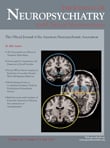A Case Report With Ziprasidone-Induced Catatonic Symptoms
Introduction
SIR: Double-blind placebo-controlled studies in schizophrenic patients without major comorbidities and not taking other antipsychotics suggest that some atypical antipsychotics such as ziprasidone may have extrapyramidal symptom profiles not different than placebo and definitively better that typical antipsychotics. 1 The use of atypicals in the general population of psychiatric patients with multiple comorbidities and polypharmacy has provided a less optimistic picture 1 and the different types of extrapyramidal symptoms have started to be described for the atypical antipsychotics.
Few cases of neuroleptic malignant syndrome (NMS) in patients taking atypical antipsychotics 2 have been described but there are almost no cases of uncomplicated catatonic syndromes associated with atypical antipsychotics. No prior cases have been published of ziprasidone-induced uncomplicated catatonia but we have found three cases of NMS associated with ziprasidone treatment. 3 – 5 This case appears to be the first case of ziprasidone-induced uncomplicated catatonic picture.
Case Report
The 21-year-old Caucasian man had a 3-year history of DSM-IV schizophrenia and no prior catatonic episodes on risperidone (up to 10 mg/day), olanzapine (up to 30 mg/day), quetiapine (up to 400 mg/day), clozapine, (up to 500 mg/day), aripiprazole (up to 30 mg/day), and haloperidol decanoate (50 mg/3 weeks).
In April 2003, the patient was taking 30 mg of aripiprazole and agreed to be switched to ziprasidone. A dose of 80 mg of ziprasidone was added on the first day, and the next day he received 160 mg of ziprasidone divided in two doses (added to the 30 mg/day of aripiprazole). The staff noted that the patient was mute, staring into space and exhibiting bizarre behavior. On day 3 after the fourth 80 mg ziprasidone dose (and no aripiprazole), the patient was examined by a psychiatrist who using the Bush-Francis Catatonia scale found the patient had posturing, mutism, bilateral arm cogwheeling and a parkisonian generalized resting tremor. He did not have other catatonic symptoms such as autonomic instability. Ziprasidone was discontinued and the patient was treated with a stat 1 mg dose of oral lorazepam. Approximately 2 hours later he became more cooperative but continued to have bilateral cogwheeling in three arm joints as well as the generalized tremor. The patient was restarted on 30 mg/day of aripiprazole on day 4. Gradually his catatonic symptoms improved and he returned to baseline by day 7.
The patient had never had catatonic symptoms on prior antipsychotics, or on aripiprazole before adding ziprasidone. He did not develop them on aripiprazole after discontinuing ziprasidone. Thus, it appears reasonable to hypothesize that ziprasidone caused the catatonic symptoms.
This case points out that atypical antipsychotics may cause catatonic symptoms as typical antipsychotics do and they need to be added to the differential diagnoses of catatonic symptoms.
1 . Pierre JM: Extrapyramidal symptoms in atypical antipsychotics: incidence, prevention and management. Drug Safety 2005; 28:191–208Google Scholar
2 . Caroff SN, Mann SC, Campbell EC, et al: Movement disorders associated with atypical antipsychotic drugs. J Clin Psychiatry 2002; 63(suppl 4):12–19Google Scholar
3 . Leibold J, Patel V, Hasan RA: Neuroleptic malignant syndrome associated with ziprasidone in an adolescent. Clin Ther 2004; 26:1105–1108Google Scholar
4 . Gray NS: Ziprasidone-related neuroleptic malignant syndrome in a patient with Parkinson’s disease: a diagnostic challenge. Hum Psychopharmacol 2004; 19:205–207Google Scholar
5 . Murty RG, Mistry SG, Chacko RC: Neuroleptic malignant syndrome with ziprasidone. J Clin Psychopharmacol 2002; 22:624–626Google Scholar



